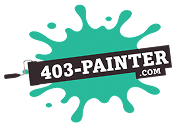A quality paint job can transform a space, making it look fresh and polished. At 403-PAINTER, we know how important a well-done paint job is. This blog will go over the key elements that make a paint job great and point out some common issues to avoid. We’ll talk about paint quality, attention to details like joints and edges, handling knobs and fixtures, ensuring smooth surfaces, and achieving consistent paint and even color coverage.
Plan Your Approach
Before you even dip your brush in paint, planning is crucial. A common mistake is to underestimate the importance of preparation. Here’s how to avoid that:
Failing to Prepare the Surface
The longevity and quality of your paint job largely depend on the surface preparation. Any professional painter will tell you that thorough cleaning, scraping off old paint, sanding uneven surfaces, and applying primer are essential steps. Skipping these can lead to peeling and chipping – a sure sign of a job that needs redoing.
Ignoring the Weather
When painting outdoors, the weather is your silent partner. Painting in overly humid conditions or in direct sunlight can cause the paint to bubble or not adhere properly. It’s best to paint in dry, mild conditions.

Choosing the Right Materials
Just as a chef needs the right ingredients, a painter needs the right materials. Here are common blunders to sidestep:
Opting for Cheap Brushes and Rollers
Investing in high-quality brushes and rollers makes a significant difference. Cheap tools often leave bristles or lint in the paint and can make it difficult to achieve a smooth finish.
Misjudging the Paint Quality
Not all paints are created equal. Residential and commercial painting projects often require different types of paint. For high-traffic areas, durability is key, so a high-quality paint that can withstand wear and tear is a good investment.

Execution Errors
The actual act of painting is where most mistakes happen. Here’s how to avoid them:
Overloading the Brush or Roller
Dipping your brush or roller too deeply into the paint can lead to drips and uneven coverage. Load the brush or roller lightly and apply the paint with even pressure.
Skipping the Tape
Taping edges is a tedious but necessary step to achieve clean lines. It might be tempting to skip this step or rush through it, but poorly taped edges can result in a sloppy look that detracts from the overall finish.
Painting Without a Plan
Starting without a strategy can lead to an inconsistent finish. Work from top to bottom and maintain a wet edge to avoid lap marks. Plan your exit from the room so you don’t paint yourself into a corner.

Post-Painting Pitfalls
The job isn’t done when the last coat dries. Here are mistakes to avoid after you’ve finished painting:
Rushing to Remove the Tape
Patience is a virtue, especially when it comes to removing painter’s tape. Wait until the paint is dry to the touch to avoid peeling off any fresh paint with the tape.
Neglecting Cleanup and Maintenance
Clean your brushes and tools immediately after use. Proper maintenance can extend their lifespan and ensure they’re ready for your next project. Also, store leftover paint properly for touch-ups or future projects.

Residential vs. Commercial Painting
While the basics of painting are similar, residential and commercial projects have their nuances. Here’s what to keep in mind:
Scale and Time Constraints
Commercial painting projects are often larger in scale and have stricter timelines. This can lead to rushed work and cutting corners, which compromises the quality. Ensure adequate time and staffing for commercial jobs.
Safety Regulations and Permits
Commercial painting often requires adherence to stricter safety regulations and may require permits. Overlooking these can lead to fines and unsafe working conditions.
Choosing the Right Finish
In commercial spaces, the right finish is not only about aesthetics but also about durability. High-gloss paints are easier to clean and resist wear, making them suitable for commercial environments, while matte finishes might be preferable for residential settings.

Professional Tips for a Perfect Finish
Even with all the right tools and preparations, technique is everything. Here are some professional tips:
Work in Sections
Paint one wall at a time, completing each section before moving on. This helps maintain a wet edge and ensures consistent coverage.
Use the 'W' or 'M' Technique
When using a roller, paint in a ‘W’ or ‘M’ pattern to distribute the paint evenly and avoid roller marks.
Don't Rush the Second Coat
Allow the first coat to dry completely before applying the second. This prevents blending wet paint, which can create streaks and uneven color.
Final Thoughts
Whether you’re painting a cozy living room or a commercial office space, avoiding these common mistakes will help you achieve a professional-looking finish. Remember, painting is as much about preparation and technique as it is about the actual application of paint.
By taking the time to prepare properly, invest in quality materials, and apply paint with care, your residential and commercial painting projects will stand the test of time and impress at first glance.

